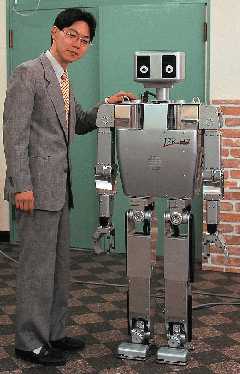Linux robot man treks into Europe [ZDNet]
Oct 25, 2001 — by Rick Lehrbaum — from the LinuxDevices Archive — viewsZDNet News reports . . .
Japanese scientists are planning to demonstrate a walking, Linux-operated, humanoid robot at an open source event in Italy next month. The bipedal H7 robot is around 137cm tall (54 inches), and… weighs 55kg (121 pounds). It has 36 joints — or “degrees of freedom” — which H7's developers claim means it has full body motion. An onboard computer, built around two Pentium III 750MHz processors, runs the RT-Linux operating system.

The appearance — at the Embedded Linux Expo in Milan, which runs from 26 to 29 November, 2001 — will be the H7 robot's first visit to Europe. The robot has been created by researchers at the JSK Laboratory in Japan, and it is hoped that it will become a useful platform for robotic developments — especially in the field of artificial intelligence.
“Human-shaped robots are well suited for operating within environments designed for real humans,” said Dr Satoshi Kagami, senior research scientist at the Digital Human Laboratory of Tokyo's National Institute of Advanced Science and technology. Dr Kagami added that H7 would “provide an experimental research platform for full-body integrated sensing and control.”
Video footage of H7 shows it is capable of walking unaided, both in a straight line and in a crab-like shuffle. The robot contains batteries weighing 4Kg, and can communicate to a network via a wireless Ethernet connection.
The team behind H7 claim that the robot is fully self-contained and can be operated without external cables. On the video footage released by JSK Laboratories H7 is connected to an external device — possibly a power source — which one researcher pushes around on a trolley after H7.
H7 is already equipped with collision-checking — allowing it to tell when it has walked into an obstacle. The scientists at JSK Laboratories are already working on 3D vision functionality that could allow H7 to avoid collisions altogether.
RTLinux is designed for robotic applications, as well as data acquisition and systems control functions. Fujitsu recently launched its own RTLinux-based robot, called Hoap-1. Fujitsu has released details of the internal architecture of Hoap-1, to help researchers and enthusiasts to design powerful applications for the robot.
Copyright © 2001, CNET Networks, Inc. All rights reserved. Reproduced with permission.
This article was originally published on LinuxDevices.com and has been donated to the open source community by QuinStreet Inc. Please visit LinuxToday.com for up-to-date news and articles about Linux and open source.